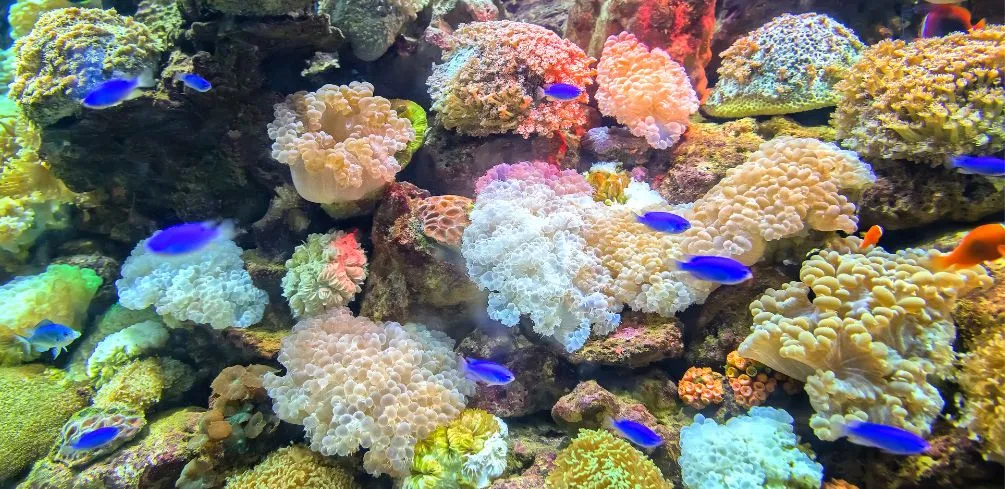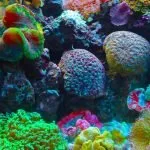Coral reefs are one of the most diverse and complex ecosystems on Earth, home to a plethora of marine animals and plants.
The coral itself is an animal, but it also serves as a habitat for countless other organisms, from tiny plankton to large fish.
This underwater world is not only beautiful to observe but also crucial for our planet’s health and well-being.
For those looking to bring a piece of this stunning environment into their homes, coral reef aquatics may be the perfect hobby.
With advances in technology and an increasing interest in sustainability, it’s now possible to recreate a small-scale version of a coral reef ecosystem in your own aquarium.
Not only does this provide an opportunity to appreciate the beauty of these underwater worlds up close, but it can also serve as a learning experience about the importance of conservation efforts for these fragile habitats.
In this article, we’ll explore everything you need to know about starting your own coral reef aquarium and how you can contribute to protecting these incredible ecosystems.
Setting Up Your Aquarium
Are you ready to set up your very own coral reef aquarium? Congratulations! Before diving in, let’s talk about some critical steps to ensure a successful setup.
First, buying the right equipment is crucial. You’ll need a tank, filter, heater, lighting, and substrate. It’s important to do your research and invest in quality products that will keep your fish and coral healthy.
Next, consider the size of your tank and plan accordingly. The size of your tank will determine how many fish and corals you can have. Make sure you have enough space for everything you want in your aquarium before making any purchases.
Additionally, think about where you want to place your tank in your home or office. Avoid placing it near windows or direct sunlight as this can cause temperature fluctuations which can be harmful to the inhabitants of the aquarium.
With proper planning and equipment selection, you’re on your way to creating a beautiful coral reef aquarium that will bring joy and wonder for years to come.
Choosing The Right Coral Types
As luck would have it, you’ve finally decided to add coral to your aquarium! But with so many types of coral out there, how do you know which one is right for your tank?
The key is to choose the right coral types based on your tank placement and lighting requirements.
Firstly, consider the location of your tank. If it’s placed in a room that has access to natural sunlight or bright artificial lights, then low-light corals such as mushrooms or leather corals may be ideal. On the other hand, if your tank is placed in a darker room, then high-light corals like SPS (small polyp stony) corals may be necessary to thrive.
Additionally, be sure to research the specific lighting requirements for each type of coral before making any purchases. When selecting coral for your aquarium, it’s also important to keep in mind their individual needs and compatibility with other species in your tank.
To help guide you in this process, here are three sub-lists to consider:
- Growth rate: Some corals grow faster than others and can quickly overtake your tank if not properly maintained.
- Water flow: Certain types of coral require stronger water flow than others. Be sure to research the preferred water flow rates for each type of coral before adding them to your tank.
- Nutrient levels: Different types of coral have varying nutrient requirements. For example, LPS (large polyp stony) corals tend to require more nutrients than SPS corals.
By taking into account both the lighting requirements and individual needs of each type of coral, you can ensure that you’re choosing the right ones for your aquarium setup.
With proper care and attention, these beautiful creatures will thrive in their new home and bring joy and wonderment to all who behold them.
Understanding Water Quality Parameters
Understanding Water Quality Parameters is crucial to the health of your aquarium’s inhabitants. Testing kits are available to monitor parameters such as pH, ammonia, nitrate, and nitrite levels. It is important to regularly test water quality to ensure that your fish and other aquatic life are living in a suitable environment.
Poor water quality can lead to stress and illness in fish which can be detrimental to their health. In addition to testing water quality, it is important to consider factors such as water filtration, nutrient balance, and lighting requirements.
Proper filtration is necessary for removing waste and other harmful substances from the water.
The nutrient balance should also be monitored, as excessive nutrients can lead to algae growth which can further harm your aquatic life. Lastly, proper lighting is essential for the growth of plants and coral in your aquarium.
By understanding these parameters and making necessary adjustments, you can maintain a healthy environment for your aquatic pets.
Maintaining A Healthy Aquarium
As aquarium enthusiasts, we all want to see our fish swimming happily in a healthy environment. However, achieving this goal requires more than just adding water and fish to the tank.
Just like any other living organism, fish need proper nutrition to thrive. A balanced diet that includes live or frozen food, pellets or flakes, and supplements will ensure that your fish receive all the essential nutrients they need.
But even with a well-balanced diet, maintaining a healthy aquarium goes beyond feeding your fish. It also involves tank cycling – the process of establishing beneficial bacteria in the aquarium’s filter media and substrate to break down waste products produced by your fish.
By cycling your tank before adding fish, you create an environment that is less stressful for them to live in. A properly cycled tank will help keep ammonia and nitrite levels low while promoting higher levels of nitrates which are less harmful to your fish.
Remember, a healthy aquarium is not only beneficial for your fish but also helps maintain the beauty of coral reef aquatics!
Supporting Coral Reef Conservation Efforts
Marine biology plays a crucial role in understanding and protecting coral reefs.
By studying the complex ecosystem of the reef, marine biologists can identify threats to its health and recommend sustainable practices to conserve it.
These practices include reducing pollution, managing fishing practices, and regulating tourism activities.
Supporting coral reef conservation efforts is not only important for preserving the beauty of these underwater ecosystems but also for maintaining the biodiversity they provide.
Coral reefs are home to countless species of fish, plants, and other marine life. When these habitats are destroyed, entire ecosystems can be disrupted.
By promoting sustainable practices and supporting conservation efforts, we can help ensure that future generations can continue to enjoy the beauty and benefits of coral reefs.
Frequently Asked Questions
What Are The Benefits Of Having A Coral Reef Aquarium?
Having a coral reef aquarium can bring about numerous benefits.
For one, it provides an opportunity for the sustainable harvesting of aquatic resources. When done responsibly and with proper care, it can actually help preserve the natural ecosystem by reducing the demand for wild-caught fish and other marine organisms.
Additionally, fish stocking in a coral reef aquarium can be highly therapeutic and relaxing. It’s like having a slice of the ocean right in your own home, allowing you to observe the beauty and diversity of sea life up close.
Not only does this add aesthetic value to your living space, but it also promotes a sense of responsibility toward marine conservation.
Ultimately, having a coral reef aquarium is not just visually pleasing but also contributes to a greater cause – protecting our oceans and its inhabitants.
Can Coral Reef Aquariums Be Harmful To The Environment?
Like all things in life, a coral reef aquarium can be a double-edged sword.
While it may seem like a beautiful addition to your home, it’s important to consider the impact it has on the environment.
Imagine taking a sip of refreshing water from a pristine lake only to realize that it’s been contaminated by pollutants. The same goes for coral reef aquatics.
Without sustainable practices and ethical sourcing, these aquariums have the potential to harm the very ecosystem they aim to mimic.
It’s crucial to educate ourselves about the consequences of our actions and take steps toward preserving our planet’s natural beauty.
Is It Possible To Have A Low-Maintenance Coral Reef Aquarium?
Having a low-maintenance coral reef aquarium is definitely possible, but it requires careful planning and attention to detail.
First of all, lighting requirements must be met in order to ensure the healthy growth of the coral.
Additionally, water chemistry must be carefully monitored and adjusted as needed to maintain the delicate balance necessary for coral survival.
While it may seem daunting at first, with the right equipment and knowledge, a low-maintenance coral reef aquarium can be a beautiful addition to any home or office space.
What Are Some Common Mistakes Beginners Make When Setting Up A Coral Reef Aquarium?
Starting off on the wrong foot can be a recipe for disaster, and that’s especially true when it comes to setting up a coral reef aquarium.
As they say, ‘you can’t make an omelet without breaking some eggs.’ When it comes to beginners setting up their first aquarium, there are some common mistakes that can lead to disappointment down the line.
Poor lighting choices and tank size are two of the most common culprits. It’s important to do your research before diving in headfirst – pun intended!
Make sure you have adequate lighting that meets the needs of your coral species and don’t skimp on tank size. It may be tempting to opt for a smaller tank, but it’s always better to give your fish and coral plenty of room to swim around and thrive.
How Can I Prevent Coral Bleaching In My Aquarium?
Preventing coral bleaching in your aquarium is essential to maintaining the health and beauty of your underwater environment.
Two important factors to consider are water flow and lighting levels. Coral reefs need a moderate water flow to keep their tissues healthy without being tossed around too much.
Similarly, lighting should be set at an appropriate level to ensure that the corals receive the right amount of energy for photosynthesis without being overly exposed or burned.
By carefully monitoring these two factors, you can prevent coral bleaching and enjoy a vibrant and thriving coral reef aquarium for years to come.
Conclusion
In conclusion, having a coral reef aquarium can bring numerous benefits, such as providing an educational and relaxing experience. However, it is important to consider the potential harm that can be inflicted on the environment if not done properly.
As responsible aquarists, we must strive to minimize our impact on the ocean and its inhabitants.
Although maintaining a coral reef aquarium may seem like a daunting task, there are ways to make it low-maintenance. For example, using automated systems for water changes and dosing supplements can greatly reduce the amount of time needed for upkeep. Additionally, choosing hardy and adaptable species of corals can also help make maintenance easier.
Lastly, preventing coral bleaching in your aquarium is crucial in preserving the health and beauty of your coral colony. This can be achieved through careful monitoring of water parameters such as temperature, pH levels, and nutrient levels.
Plus, providing adequate lighting and flow for your corals can mimic their natural environment and promote growth.
As with any hobby or endeavor, there will always be room for improvement and learning. By staying informed and making conscious choices in our practices, we can enjoy the beauty of coral reef aquatics while also protecting our oceans for future generations to come.





